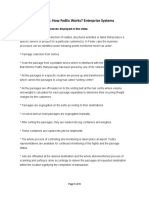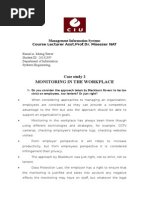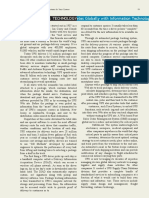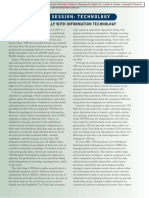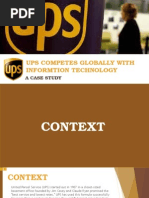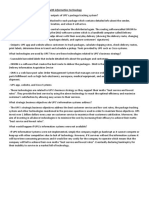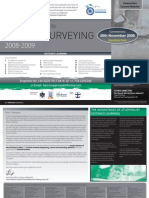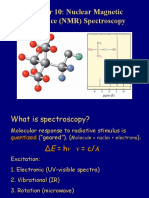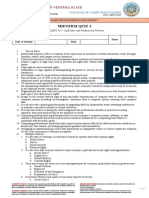0 ratings0% found this document useful (0 votes)
193 viewsCase Study 1 UPSGlobal Operations With The DIAD IV
Case Study 1 UPSGlobal Operations With The DIAD IV
Uploaded by
كمال الطويرThis document contains a case study about UPS global operations and the role of information technology. It discusses how UPS uses smart labels, the DIAD IV handheld device, and wireless communication between drivers and processing centers. Packages are picked up, information is sent to processing centers, packages are sorted and loaded onto trucks guided by the DIAD IV. Upon delivery, signatures are collected digitally. IT has transformed package delivery by making it more efficient, reliable, and lower cost, allowing UPS to achieve strategic objectives like operational efficiency, compressed delivery times, and new tracking services.
Copyright:
© All Rights Reserved
Available Formats
Download as DOCX, PDF, TXT or read online from Scribd
Case Study 1 UPSGlobal Operations With The DIAD IV
Case Study 1 UPSGlobal Operations With The DIAD IV
Uploaded by
كمال الطوير0 ratings0% found this document useful (0 votes)
193 views3 pagesThis document contains a case study about UPS global operations and the role of information technology. It discusses how UPS uses smart labels, the DIAD IV handheld device, and wireless communication between drivers and processing centers. Packages are picked up, information is sent to processing centers, packages are sorted and loaded onto trucks guided by the DIAD IV. Upon delivery, signatures are collected digitally. IT has transformed package delivery by making it more efficient, reliable, and lower cost, allowing UPS to achieve strategic objectives like operational efficiency, compressed delivery times, and new tracking services.
Original Description:
Case Study - UPSGlobal Operations With the DIAD IV
Original Title
Case Study 1 UPSGlobal Operations With the DIAD IV
Copyright
© © All Rights Reserved
Available Formats
DOCX, PDF, TXT or read online from Scribd
Share this document
Did you find this document useful?
Is this content inappropriate?
This document contains a case study about UPS global operations and the role of information technology. It discusses how UPS uses smart labels, the DIAD IV handheld device, and wireless communication between drivers and processing centers. Packages are picked up, information is sent to processing centers, packages are sorted and loaded onto trucks guided by the DIAD IV. Upon delivery, signatures are collected digitally. IT has transformed package delivery by making it more efficient, reliable, and lower cost, allowing UPS to achieve strategic objectives like operational efficiency, compressed delivery times, and new tracking services.
Copyright:
© All Rights Reserved
Available Formats
Download as DOCX, PDF, TXT or read online from Scribd
Download as docx, pdf, or txt
0 ratings0% found this document useful (0 votes)
193 views3 pagesCase Study 1 UPSGlobal Operations With The DIAD IV
Case Study 1 UPSGlobal Operations With The DIAD IV
Uploaded by
كمال الطويرThis document contains a case study about UPS global operations and the role of information technology. It discusses how UPS uses smart labels, the DIAD IV handheld device, and wireless communication between drivers and processing centers. Packages are picked up, information is sent to processing centers, packages are sorted and loaded onto trucks guided by the DIAD IV. Upon delivery, signatures are collected digitally. IT has transformed package delivery by making it more efficient, reliable, and lower cost, allowing UPS to achieve strategic objectives like operational efficiency, compressed delivery times, and new tracking services.
Copyright:
© All Rights Reserved
Available Formats
Download as DOCX, PDF, TXT or read online from Scribd
Download as docx, pdf, or txt
You are on page 1of 3
Management Information
Systems
Course Lecturer Asst.Prof.Dr. Messer NAT
Kamal A. Mutug Tawer
Student ID: 20132397
Department of Information
Systems Engineering,
Case study 1
UPS Global Operations with the DIAD IV
1. What are UPS Smart Labels? What role do they play in
UPS operations?
UPS Smart Labels are bar coded labels that are used to initiate a UPS
transaction. The bar code label contains all the key information about the
customer, the package size, destination and weight. This information is sent
immediately to a UPS processing center at the very time it is created with a
UPS drivers hand held computer (the DIAD IV). The smart labels become the
control document used throughout the transaction right through to final
delivery.
2. Write out the steps a package takes from pick-up by a UPS
driver to delivery including the role of DIAD, the UPS Data
Center, and the UPS Package Center.
Smart label created.
Information sent to processing center.
Information processedstored, address corrected.
Information matched to dispatch plan.
Package is sorted.
Another label is printed specifying delivery truck and position on truck.
Geo software used to continuously update dispatch plans for trucks
based on current load.
Information is displayed on the DIAD IV identifying drop off order,
position on truck.
At delivery, package scanned. Information sent wirelessly to processing
center.
Customers sign on the dotted line on the DIAD IV.
Main processing centers store complete track of package for customer
tracking.
3. What role does wireless communication play in the UPS
systems?
DIAD IV is wirelessly connected to the main processing centers and the
package centers. Generally UPS trucks contain a transceiver to work with the
local driver's DIAD IV, and then communicate that information wirelessly back
to the UPS processing center.
4. How has information technology transformed the package
delivery business?
Package delivery used to take many days and even weeks prior to the
development of the UPS technologies described in this video. Now next day
service is available anywhere in the United States, and around the world.
Information technology has made the industry much more efficient, reliable,
and lower in cost to the customer. IT has enhanced the competitive position of
UPS and others like FedEx vis a vis the U.S. Postal Service, and prior local
delivery services which no longer exist because of the success of UPS and
FedEx.
5. How does UPSs investment in IT help it achieve the
strategic business objectives described in Chapter 1?
The most important contributions of technology to UPS strategic objectives is
the greatly enhanced operational efficiency; the compression of time to
deliver; the development of new services like tracking, and overnight or 2-day
service; the closeness to the customer; improvements in the quality and
speed of decisions related to packages.
Firms that made these investments in IT benefit by achieving significant
competitive advantage over others in the package delivery business. FedEx
remains a much smaller but competitive service especially in the overnight
market. Other competitors have largely disappeared.
You might also like
- UPS - RevisedDocument7 pagesUPS - RevisedSherilyn Gautama100% (1)
- UPS Competes Globally With Information TechnologyDocument3 pagesUPS Competes Globally With Information TechnologyCandypop67% (3)
- Waukesha VHP 6 Cylinders Parts Catalog G/GSI/GLDocument209 pagesWaukesha VHP 6 Cylinders Parts Catalog G/GSI/GLMuhammadShadab83% (12)
- BDO Audit Plan and ProgramDocument22 pagesBDO Audit Plan and ProgramRicart Von Laureta100% (1)
- Assessment Nursing Diagnosis Planning Implementation Scientific Rationale EvaluationDocument5 pagesAssessment Nursing Diagnosis Planning Implementation Scientific Rationale Evaluationjennelyn losanta100% (2)
- Chapter 1 UPS COMPETES GLOBALLYDocument3 pagesChapter 1 UPS COMPETES GLOBALLYJessuel Larn-epsNo ratings yet
- UPS Competes Globally With Information TechnologyDocument2 pagesUPS Competes Globally With Information TechnologyRizky AgungNo ratings yet
- Video Case Answers ESS11 - REV 2-14-14Document43 pagesVideo Case Answers ESS11 - REV 2-14-14Ahamed NajathNo ratings yet
- FedEx Case Study AnswersDocument4 pagesFedEx Case Study AnswersFaisal Mirza100% (2)
- Case 2-1 Rheaco, Inc.: Making A Quality Turnabout by Asking For AdviceDocument18 pagesCase 2-1 Rheaco, Inc.: Making A Quality Turnabout by Asking For Adviceكمال الطويرNo ratings yet
- Case Study 2Document4 pagesCase Study 2كمال الطويرNo ratings yet
- Ups Case Study MisDocument5 pagesUps Case Study MisSagar PatilNo ratings yet
- Emis10 Ch01 Case1 UpsglobalDocument4 pagesEmis10 Ch01 Case1 UpsglobalAndrea Santos GonzálezNo ratings yet
- Chapter 1, Case 1 UPS Global Operations With The DIAD IVDocument4 pagesChapter 1, Case 1 UPS Global Operations With The DIAD IVAlberto C. RamosNo ratings yet
- UPS Diad Case PDFDocument2 pagesUPS Diad Case PDFSadia RahmanNo ratings yet
- UPS DIAD Case StudyDocument5 pagesUPS DIAD Case StudyShrouk__Anas100% (1)
- UPS Global Operations With The DIAD IV: Kenneth C. Laudon and Jane P. LaudonDocument4 pagesUPS Global Operations With The DIAD IV: Kenneth C. Laudon and Jane P. LaudonMohammed AsadujjamanNo ratings yet
- UPS Competes Globally With Information TechnologyDocument6 pagesUPS Competes Globally With Information TechnologyMuhammadYudithEddwina100% (2)
- Question No 1Document18 pagesQuestion No 1Eyah QaderNo ratings yet
- UPS Case Study Original TextDocument4 pagesUPS Case Study Original TextBT NhiNo ratings yet
- INF204A Fall 2023-Gropup Case Study No 02-UPSDocument2 pagesINF204A Fall 2023-Gropup Case Study No 02-UPSHilland GinnyNo ratings yet
- USP Case Study TSI Fatima OulamineDocument2 pagesUSP Case Study TSI Fatima OulaminefatimaoulamineNo ratings yet
- UPS Competes Globally With Information TechnologyDocument3 pagesUPS Competes Globally With Information TechnologyBiweshNo ratings yet
- Sisfor Tugas Case Study Ups 2207412013Document3 pagesSisfor Tugas Case Study Ups 2207412013Ragiliawan PutraNo ratings yet
- UPS Competes Globally With Information TechnologyDocument2 pagesUPS Competes Globally With Information TechnologyRizky Agung100% (1)
- AssignmentDocument2 pagesAssignmentKebebu GirmaNo ratings yet
- MIS MidtermmmDocument22 pagesMIS MidtermmmNa ViNo ratings yet
- MIS MidtermDocument19 pagesMIS Midtermtuongnado01No ratings yet
- Management Information Systems: Kenneth C. Laudon Jane P. LaudonDocument4 pagesManagement Information Systems: Kenneth C. Laudon Jane P. LaudonsantiNo ratings yet
- UPS Case Study - Original TextDocument10 pagesUPS Case Study - Original TextQuy Nguyen QuangNo ratings yet
- Interactive Session: Technology: Ups Competes Globally With Information TechnologyDocument2 pagesInteractive Session: Technology: Ups Competes Globally With Information Technology4p86ymwgjwNo ratings yet
- Q1. What Are The Inputs, Processing, and Outputs of UPS's Package Tracking System?Document3 pagesQ1. What Are The Inputs, Processing, and Outputs of UPS's Package Tracking System?Desmond B. Okyere100% (1)
- Case Study answers-MGEDocument3 pagesCase Study answers-MGEluluaftimos1308No ratings yet
- Interactive Session: Technology: Ups Competes Globally With Information TechnologyDocument2 pagesInteractive Session: Technology: Ups Competes Globally With Information TechnologyAsifNo ratings yet
- Ch1-7 CaseDocument19 pagesCh1-7 Casennvanh.baiuNo ratings yet
- Case Study 1Document4 pagesCase Study 1Emmanuel KutaniNo ratings yet
- UPS Marketing StrategyDocument5 pagesUPS Marketing StrategyRobbi WanNo ratings yet
- Assignment OneDocument3 pagesAssignment OneRenatta GomezNo ratings yet
- UPS Case StudyDocument2 pagesUPS Case StudyJehan Zeb33% (3)
- Ups Competes Globally With Information TechnologyDocument42 pagesUps Competes Globally With Information TechnologyJohn Sum75% (4)
- Case 1 DIAD and Case 2 GOOGLEDocument6 pagesCase 1 DIAD and Case 2 GOOGLERenz Mari AcuñaNo ratings yet
- Information Systm Course-Assignment on UPS & Mobile Handheld Device-editedDocument9 pagesInformation Systm Course-Assignment on UPS & Mobile Handheld Device-editeddawit kassaNo ratings yet
- HOPEDocument4 pagesHOPEKanimi Taiwo peretunNo ratings yet
- MIS AssignmentDocument3 pagesMIS AssignmentdiaamustafaNo ratings yet
- ERP Ass 2Document5 pagesERP Ass 2muhammadusamppNo ratings yet
- MBA5401 - CS - Unit II - Hoi TU - Sep 3 - 2020 - SubmitDocument12 pagesMBA5401 - CS - Unit II - Hoi TU - Sep 3 - 2020 - SubmitTu HoiNo ratings yet
- Case Study 1Document5 pagesCase Study 1Emmanuel KutaniNo ratings yet
- Question 1: What Are The Inputs, Processing, and Outputs of UPS's Package Tracking System?Document2 pagesQuestion 1: What Are The Inputs, Processing, and Outputs of UPS's Package Tracking System?Sifat Shaharia100% (1)
- Uzair Abdul Gani: Bs (Aviation Management)Document4 pagesUzair Abdul Gani: Bs (Aviation Management)Malik UzairNo ratings yet
- UPS Global Operations With DIAD and Worldport: Kenneth C. Laudon and Jane P. LaudonDocument4 pagesUPS Global Operations With DIAD and Worldport: Kenneth C. Laudon and Jane P. LaudonhouyamelkandoussiNo ratings yet
- FedEx - Competitive Advantage Through Information TechnologyDocument9 pagesFedEx - Competitive Advantage Through Information Technologyrakeshb11100% (3)
- Chapter 1 Video Case2 UPSDocument4 pagesChapter 1 Video Case2 UPSamal.benharizNo ratings yet
- UPS Marketing StrategyDocument5 pagesUPS Marketing StrategyTrần Thị Hồng NgọcNo ratings yet
- Individual MISDocument18 pagesIndividual MISNam NguyễnNo ratings yet
- Case Study UPS & MashaweerDocument12 pagesCase Study UPS & MashaweerMalik of ChakwalNo ratings yet
- Case Study: UPS Competes Globally With Information TechnologyDocument1 pageCase Study: UPS Competes Globally With Information Technologyfor work onlyNo ratings yet
- Case Study QuestionsDocument2 pagesCase Study Questions9tcqyrm8dpNo ratings yet
- UPS Case Study Assignment Ayesha Ikram MBA ProfessionalDocument2 pagesUPS Case Study Assignment Ayesha Ikram MBA ProfessionalUmt Bbis100% (2)
- Question 2 (CSC Management)Document5 pagesQuestion 2 (CSC Management)firdaus azizjaafarNo ratings yet
- UPS Case StudyDocument1 pageUPS Case StudyHà Quảng TâyNo ratings yet
- Case Study No. 1 Ups Competes Globally With Information TechnologyDocument3 pagesCase Study No. 1 Ups Competes Globally With Information TechnologyAmrani LisaNo ratings yet
- MIS - Unit II - Duyen - HOM59Document14 pagesMIS - Unit II - Duyen - HOM59Duyên CaoNo ratings yet
- Case UpsDocument2 pagesCase UpsMarivi Dorado OrtizNo ratings yet
- Mobile Computing: Securing your workforceFrom EverandMobile Computing: Securing your workforceBCS, The Chartered Institute for ITNo ratings yet
- Data Entry: A Guide to Data Entry Operations That Make Money OnlineFrom EverandData Entry: A Guide to Data Entry Operations That Make Money OnlineNo ratings yet
- NETWORKDocument13 pagesNETWORKكمال الطويرNo ratings yet
- Comparison Between Internet Protocol Version 4 and 6Document9 pagesComparison Between Internet Protocol Version 4 and 6كمال الطويرNo ratings yet
- شبتر رقم 1 مادة نظم المعلومات الاداريةDocument10 pagesشبتر رقم 1 مادة نظم المعلومات الاداريةكمال الطويرNo ratings yet
- HOLE TYPE IQI (Penetrameter)Document5 pagesHOLE TYPE IQI (Penetrameter)Eswar Enterprises Qc100% (1)
- Flight International - 31 March 2020 PDFDocument36 pagesFlight International - 31 March 2020 PDFJacques Savariau100% (1)
- LM1333 Marine Surveying (KL)Document8 pagesLM1333 Marine Surveying (KL)majdirossrossNo ratings yet
- CENGR 3270 Ce Laws, Ethics and Contracts: The Engineering Education, Personal and Ethical Relations Research Work No. 1Document15 pagesCENGR 3270 Ce Laws, Ethics and Contracts: The Engineering Education, Personal and Ethical Relations Research Work No. 1Bao yifanNo ratings yet
- Module 2 & 3Document8 pagesModule 2 & 3Delanir VillartaNo ratings yet
- Chapter 10: Nuclear Magnetic Resonance (NMR) SpectrosDocument86 pagesChapter 10: Nuclear Magnetic Resonance (NMR) SpectrosNu'man HasisNo ratings yet
- Explicit Instruction ModelDocument2 pagesExplicit Instruction ModelkatemcarthurNo ratings yet
- Fuel GuardDocument2 pagesFuel GuardEdisonCorderoNo ratings yet
- Principles of Erosion ControlDocument14 pagesPrinciples of Erosion ControlsaurabhNo ratings yet
- Minutes of Pre-Bid Meeting TESDADocument7 pagesMinutes of Pre-Bid Meeting TESDADexie Cabañelez ManahanNo ratings yet
- IP Office ManagerDocument964 pagesIP Office ManagerNick JewettNo ratings yet
- H 100 ManualDocument262 pagesH 100 ManualMurat CanNo ratings yet
- Schneider - AC Charger 22 KWDocument3 pagesSchneider - AC Charger 22 KWAmr EidNo ratings yet
- Fault Tolerant Systems: Chapter 1: PRELIMINARIESDocument14 pagesFault Tolerant Systems: Chapter 1: PRELIMINARIESKisalay KumarNo ratings yet
- Holiday List 2025Document4 pagesHoliday List 2025bikashkandapan0No ratings yet
- Contact Lens-Induced Limbal Stem Cell Deficiency - EyeWikiDocument4 pagesContact Lens-Induced Limbal Stem Cell Deficiency - EyeWikiSania NadianisaNo ratings yet
- Alpha DesignDocument12 pagesAlpha DesignIp Wai MengNo ratings yet
- CHAPTER 5-I AGR113Document39 pagesCHAPTER 5-I AGR1132024294166No ratings yet
- Development Perspective (ATC) - 1Document98 pagesDevelopment Perspective (ATC) - 1Adam SolomoniNo ratings yet
- BC Hydro Site C Injunction: Affidavit #1 of Patrick HayesDocument143 pagesBC Hydro Site C Injunction: Affidavit #1 of Patrick HayesJonny WakefieldNo ratings yet
- Database and Web Database Systems: SQL: Data ManipulationDocument117 pagesDatabase and Web Database Systems: SQL: Data ManipulationAiyas AboobakarNo ratings yet
- Electricity God's PowerDocument7 pagesElectricity God's PowerMark Rowan100% (2)
- Food Science Book Online PDFDocument216 pagesFood Science Book Online PDFrinkyNo ratings yet
- Performance Analysis and Comparison of Conventional and Interleaved DC/DC Boost Converter Using MULTISMDocument10 pagesPerformance Analysis and Comparison of Conventional and Interleaved DC/DC Boost Converter Using MULTISMIam AbdiwaliNo ratings yet
- I Am A Bird by Kathrina Haji Mohd DaudDocument2 pagesI Am A Bird by Kathrina Haji Mohd DaudLloyd Daniel100% (1)
- CpE Laws - Midterm Quiz 2Document3 pagesCpE Laws - Midterm Quiz 2Gi dela CruzNo ratings yet
- Resume Updates9 20 BoschDocument1 pageResume Updates9 20 Boschapi-347637717No ratings yet








